Talking SOP May 2013 [PDF, 735.49 Kb] - Tessenderlo Group
Talking SOP May 2013 [PDF, 735.49 Kb] - Tessenderlo Group
Talking SOP May 2013 [PDF, 735.49 Kb] - Tessenderlo Group
You also want an ePaper? Increase the reach of your titles
YUMPU automatically turns print PDFs into web optimized ePapers that Google loves.
was brought to America by a sailor returning fromChina. Its main development in the USA startedafter the Second World War, and was followedby development in Argentina and Brazil from the1970’s onwards (Fig. 1).Soybeans:a success storyDevelopment of the soybean crop is unique in the world of agriculture. At the end ofthe 19 th century, cropping was primarily limited to Asia. However, a large expansionin production started in the 20th century after the Second World War, first in theUSA and in the 1970’s and 80’s in South America, mainly in Brazil and Argentina.Soybeans now cover the fourth largest acreage in the world after wheat, maize andrice, with 260 million tons produced on more than 103 million hectares.Main soybean production andcropping areasCountry Production Area(tons)(ha)USA 83,171,600 29,799,800Brazil 74,815,400 23,968,700Argentina 48,878,800 18,764,900India 14,485,105 9,950,000The soybean is a leguminous vegetable of thepea family. It is primarily grown for oil but also isa valuable source of protein and is widely usedin human and animal nutrition. The plant grows intropical, subtropical and temperate climates andwas first domesticated in the northeast of Chinamore than 2000 years ago.By the 15th and 16th centuries, the soybean hadbeen introduced into India and Japan as well asinto several countries in South East Asia. But itwas not until the end of the 19th century that itFor centuries in Asia, the soybean was usedmainly for preparing a large variety of fresh,fermented and dried foods. It was not used toany great extent for animal feed, contrary to inthe USA where its first use was for forage and, tosome extent, as green manure. As a legume, theplant also improves soil fertility by fixing nitrogenfrom the atmosphere.The soybean consists of 20% oil, more than 36%protein, 30% carbohydrate and good quantities offibre, vitamins and minerals. Today, the majorityof the crop is processed into oil and meal and itaccounts for around two thirds of the edible fatsand oils consumed in the USA.Soybean oil is also used by industry and, morerecently, as a biofuel product. The high proteincake resulting from oil extraction can be processedinto soybean flour for human consumption orincorporated into animal feeds to complementmaize and wheat grains.Soybean croppingSoybeans grow in a warm, moist climate, similarclimatic conditions as for maize. The minimumtemperature for effective plant growth is about10°C, as lower temperatures tend to delayflowering. Effective cultivation requires a welldrainedloamy soil with a pH from 6.0 to 7.5.Sodic and saline soils inhibit germination of theseeds and should be avoided.On soils prone to leaching, mineral fertilization canbe split into two or more applications and on lowfertility soils, it is often more efficient to apply thefertilizer in a band along the seedling row.China 12,282,000 7,650,057Paraguay 8,309,790 2,805,470Canada 4,246,300 1,542,400Fig. 1: Evolution of soybean global productionand cropping area 1961 - 2011Russia 2,299,860 1,187,400Ukraine 2,264,400 1,110,300Bolivia 1,756,010 1,023,960Uruguay 1,541,000 862,100Other 6,865,606 4,328,159Total 260,915,871 102,993,246Source: FAO <strong>2013</strong> (data from 2011)K-Leaf TM SoluPotasse ® GranuPotasse ® Standard <strong>SOP</strong>


![Talking SOP May 2013 [PDF, 735.49 Kb] - Tessenderlo Group](https://img.yumpu.com/41045284/2/500x640/talking-sop-may-2013-pdf-73549-kb-tessenderlo-group.jpg)
![Slides [PDF, 378.59 Kb] - Tessenderlo Group](https://img.yumpu.com/49205668/1/190x143/slides-pdf-37859-kb-tessenderlo-group.jpg?quality=85)
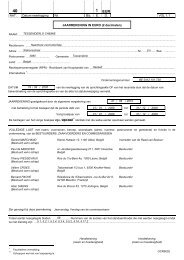
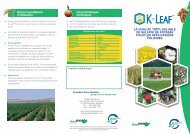
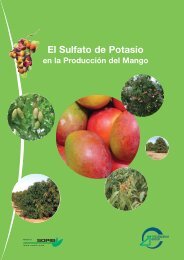
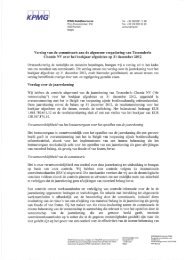

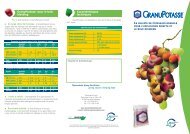
![Investor Seminar Presentation [PDF, 997.72 Kb] - Tessenderlo Group](https://img.yumpu.com/45992427/1/190x143/investor-seminar-presentation-pdf-99772-kb-tessenderlo-group.jpg?quality=85)
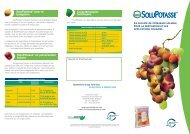
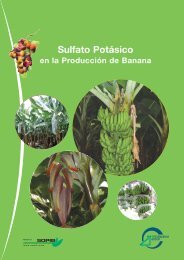
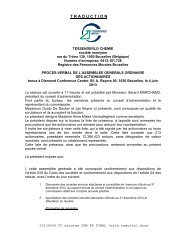

![Talking SOP September 2012 [PDF, 673.84 Kb] - Tessenderlo Group](https://img.yumpu.com/37691694/1/184x260/talking-sop-september-2012-pdf-67384-kb-tessenderlo-group.jpg?quality=85)
![Annual Report 2008 English [PDF, 2.69 MB] - Tessenderlo Group](https://img.yumpu.com/37691533/1/184x260/annual-report-2008-english-pdf-269-mb-tessenderlo-group.jpg?quality=85)